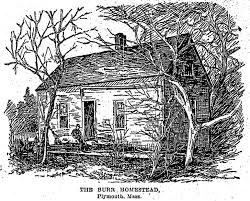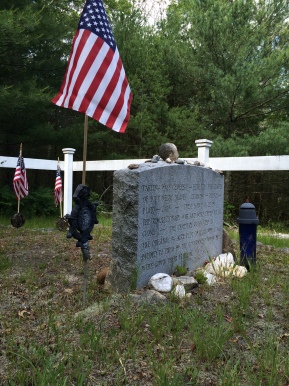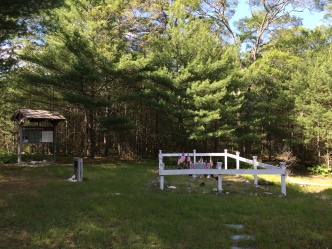
A rendering of the Turner-Burr house from Taylor’s 1895 Boston Globe article. The once-isolated crossroads is now the busy intersection of Route 80 and Parting Ways Road.
Just a few days after Thanksgiving 1895, a reporter from the Boston Globe rode out from the village of Plymouth, Massachusetts as “the rain did a merry song and dance in the sandy roads.”[1] At a time of year when many were preoccupied with the story of the Pilgrims, J.N. Taylor sought to satisfy his curiosity regarding a different kind of history–that of the old African-American settlement on the far outskirts of town at an isolated crossroads known as Parting Ways. In 1895, there was but one remaining house at the place where the Carver and Plympton roads parted amidst scrub oak and pine. There resided the last few inhabitants of Plymouth’s “New Guinea,” a settlement originally established by African-American veterans of the Revolutionary War and one of the earliest independent communities of freedmen in New England.
The piece that Taylor wrote focused on the elderly James Thurston Burr, grandson of one of the first residents of New Guinea, painting him as a friendly eccentric and recounting some anecdotes from his remarkable life. Taylor did not dig much into the extraordinary story of the settlement itself and therefore missed an opportunity to better document a site which holds great significance to the history of the early days of emancipation in Massachusetts.
Burr, 73 years old when interviewed, had resided at Parting Ways for 34 years with a female cousin, Rachel Turner Johnson and her two or three sons. Born in Boston in 1822, Burr became a printer’s apprentice in the employ of activist William Lloyd Garrison who published the controversial abolitionist newspaper, the Liberator. Burr claimed he was there in the Liberator office in 1835 when the infamous anti-abolitionist mob surrounded and broke into the building, captured Garrison and hauled him through the streets at the end of a rope. Shortly thereafter, Burr got out of the printing business, became a barber, then worked as a servant for politician and industrialist Abbott Lawrence (1792-1855), a representative to Congress and Minister to Great Britain. Taylor asked Burr a good deal about life in Washington and England in the 1830s and 40s but apparently not very much about the ground upon which they stood.
Still, Taylor learned that Burr left Boston and came to New Guinea at Parting Ways about the time of the outbreak of the Civil War in 1861. He “settled on the place cleared by his dead and gone relatives. Here he has been ever since, close to the graves of his ancestors, which are unmarked in a small clearing, rank with weeds.”[2] Burr moved in with his cousin Rachel and her family, residing in a house which archaeologist Karen Hutchins-Keim estimates was built by Rachel’s father, James Turner (son of Plato Turner, one of the first residents) around 1830.[3] At the time of Taylor’s writing in 1895, it was the only one of New Guinea’s houses still standing. Other dwellings were marked by “five yawns in the ground” where cellar holes remained. The Turner-Burr house, the last remnant of the settlement, stood until about 1908 when it probably burned down.[4]

Grave site of the African-American Revolutionary War Veterans
Roughly 105 years before Taylor’s visit with James Burr at Parting Ways, four African-American veterans of the Revolutionary War established the settlement with their families. At least three and perhaps all four had been slaves before the war. The soil in the area of Parting Ways is sandy and poor for farming. Unable to sell the land off, the Town had retained it as a common sheep pasture. During the mid to late 18th century several poor and transient families squatted there, including the family of Seth Fuller who, in the 1760s, came to some tacit agreement with the town and was allowed to build a small house at the crossroads.[5] In 1779, in between enlistments with the Continental Army, Plato Turner, a free African-American, purchased Seth Fuller’s house. At the close of the war, the dwelling became the nucleus of Plymouth’s New Guinea.
Plato Turner, held in slavery before the war, enlisted with the 3rd Massachusetts Regiment in 1776, serving in upstate New York during the Canadian campaign of 1776-1777. He served during the Battle of Valcour Bay on Lake Champlain and the decisive American victory at Saratoga, among other battles.[6] Finishing out his first enlistment in 1779, he was declared a freeman, returned to Plymouth for a short time and purchased the Seth Fuller house at Parting Ways.[7] He signed up for a second enlistment, serving with the 2nd Massachusetts Regiment and again with the 3rd Massachusetts in garrison duty at West Point. He was discharged and returned home in 1783.
Cato Howe enlisted in 1775 at age 25 with the 2nd Massachusetts Regiment and was present during the Battle of Bunker Hill on June 17, 1775.[8] While it seems, according to most sources, that Howe was a slave before the war, there are discrepancies with some sources indicating Howe was born a freeman.[9] He served at Valley Forge and the Battle of Monmouth, among other actions, remaining in the army until at least 1780 and returned home to Plymouth near the close of the war.
Quamany Quash enlisted while enslaved, owned by Colonel Theophilus Cotton, the commanding officer of the Plymouth County militia regiment and a leader among the local Sons of Liberty. Quamany’s first name was probably derived from the Asante name Kwame, or a boy born on a Saturday. His paternal name came from his father Quash Quande, a slave belonging to Dr. Lazarus LeBaron of Plymouth, and likely derived from the Asante name Kwesi Kwande, or a boy born on a Sunday.[10] Quash served under the command of the man who claimed ownership of him during the Siege of Boston. He then served with the 2nd Massachusetts Regiment under Colonel John Bailey along with Cato Howe at Valley Forge and in a number of major engagements in New Jersey. When Quash turned 21 in 1781, Cotton drew up his manumission papers, granting Quash his bounty for joining the army but keeping one half of his wages.[11]
Prince Goodwin enlisted while held in slavery, owned by Judge Joshua Thomas of Plymouth. He served with the 7th Massachusetts Regiment, deserted in 1777 and therefore was not granted his freedom during the war as were the other founders of the New Guinea settlement.[12] He went back to the Thomas family and continued to reside with them part time as a servant even after manumission in 1783, dividing his time between their household and his household at Parting Ways.
As mentioned, Turner was the first to take up residence at Parting Ways in 1779 when he bought the Seth Fuller house. Howe, Quash and Goodwin built houses there by 1790. On March 12, 1792, the Town of Plymouth granted a strip of land consisting of 93 acres “to such persons as will clear the same in the term of three years.” Although they are not named, this was voted, according to tradition, in recognition of four men’s service in the Continental Army, granting them the land on which their houses already stood. According to Karen Hutchins-Keim, “Of the 54 African-Americans living in Plymouth in 1790, only 13 lived autonomously from white households…All of those 13 individuals lived at Parting Ways.” Although it was a difficult, hardscrabble existence, the community grew modestly and persisted well into the 19th century. As Hutchins-Keim wrote, “the households at Parting Ways marked an important milestone in the development of free black communities in the area.”[13]
As America’s 200th anniversary approached, local interest in these Revolutionary War veterans of Partings Ways grew. The Plymouth Bicentennial Committee on Afro-American History engaged Dr. James Deetz, Professor of Anthropology at Brown University and Assistant Director of Plimoth Plantation, to conduct an archaeological dig at Parting Ways in 1975 and 1976. Professor Deetz and his crew of archaeologists and volunteers focused on the sites of the Turner houses, including the foundation of the Turner-Burr house in which Taylor interviewed James Burr in 1895. Deetz published his findings in his book In Small Things Forgotten in 1977.
As Karen Hutchins-Keim emphasizes in her recent re-examination of Deetz’s findings, Deetz saw suggestions, as he wrote, “that an African mind-set was at work” in the material culture of the Parting Ways settlement. Deetz observed similarities between the foundations at Parting Ways and those of the so-called “shotgun” slave dwellings in the American South. “The shotgun house,” Deetz wrote, “is acknowledged as a true African American architectural form. Not only does the Burr house plan conform to the ground plans of shotgun houses, the dimensions are remarkably similar.”[14] He also compared the Parting Ways structures to West African Yoruba dwellings. The clustered pattern of the buildings, he believed, was in keeping with African tradition as opposed to the more open Anglo-American settlement pattern. Perhaps most significant, fragmented clay pots were unearthed bearing a considerable resemblance, Deetz believed, to West African jars used to store and transport tamarind fruit, suggesting a persisting tradition in material culture.

Parting Ways Cemetery
Hutchins-Keim is quick to stress that in years since Deetz’s publication, “Some scholars have utilized his research with perhaps more authority and decisiveness than Deetz himself intended.”[15] She points out that one of the structures excavated was in fact built by Anglo-American settler Seth Fuller and that the Turner-Burr house was entirely consistent with Anglo-American houses of the period. Nonetheless, she argues, the site still has a great deal “to inform us about the formation of African-American, racial, and American identities if we look at the location and arrangement of the houses in the context of community formation and the physical and sociocultural landscape.”[16] The location and use of the land in contrast to the village of Plymouth itself, according to Hutchins-Keim, illuminates the process of racialization during the early republic.
Efforts to build a museum and educational center associated with the site have been ongoing since the 1970s. Such a facility, as envisioned by the Parting Ways Museum of Afro-American EthnoHistory, Inc. would exhibit the archaeological material, interpret the history of the site and establish a cultural center to research diversity issues and promote African heritage.[17] A granite marker was placed at the cemetery site over the graves of the “first four” founders of the settlement. In 2012, the Parting Ways Museum, Town of Plymouth and the Plymouth County Convention and Visitors Bureau collaborated to install a large interpretive sign at the site. To learn more about the project and this remarkable site, visit the Parting Ways project website.
[1] J.N. Taylor, “Jim Burr’s Life, History of Plymouth’s Colored Citizen,” Boston Globe, December 8, 1895, 32.
[2] Taylor, “Jim Burr’s Life.”
[3] Karen A. Hutchins-Keim, “Parting Ways Revisited: Archaeology at a Nineteenth-Century African-American Community in Plymouth, Massachusetts,” Journal of African Diaspora Archaeology & Heritage, Vol. 4 No. 2, July, 2015, 127.
[4] James Deetz, In Small Things Forgotten: An Archaeology of Early American Life, (New York: Anchor Books, Doubleday 1996), 197.
[5] Hutchins-Keim, “Parting Ways Revisited,” 123.
[6] Town of Plymouth, “Parting Ways Cemetery,” marker at New Guinea Settlement site, placed 2012. For images and further information see “New Sign at Parting Ways Cemetery Celebrates a ‘Dream Realized,’” Plymouth Patch, January 15, 2012.
[7] Hutchins-Keim, “Parting Ways Revisited,” 123.
[8] James Deetz, In Small Things Forgotten, 187.
[9] Pilgrim Hall Museum, “Long Road to Freedom: African-Americans in the Old Colony,” http://www.pilgrimhallmuseum.org/long_road_to_freedom.htm
[10] James Oliver Horton and Lois E. Horton, In Hope of Liberty: Culture, Community and Protest Among Northern Free Blacks, 1700-1860, (New York: Oxford University Press, 1998), 78.
[11] Pilgrim Hall Museum, “Long Road to Freedom.”
[12] James Deetz, In Small Things Forgotten, 192.
[13] Hutchins-Keim, “Parting Ways Revisited,” 134.
[14] James Deetz, In Small Things Forgotten, 203.
[15] Hutchins-Keim, “Parting Ways Revisited,” 121.
[16] Hutchins-Keim, “Parting Ways Revisited,” 129.
[17] The Parting Ways Museum of Afro-American EthnoHistory, “Mission Statement“

October 13th, 2016 at 3:09 pm
This is so interesting!!!! I wish I could remember more but, I was so young! I remember the digs at Parting Ways & my mother Marjorie Anderson working so hard to get Parting Ways Started.But not much more!!!
October 13th, 2016 at 3:41 pm
Thanks for commenting, Sherry. Must have been really neat to see that going on.
April 3rd, 2017 at 3:23 pm
I just discovered that Plato Turner is the 5th great-grandfather of my children. I’m a bit confused because the research I’ve done through Ancestry.com does not list a son named James. From what I have seen, Plato Turner had only one son, Sumner. Is it possible that Sumner and James Turner are the same person? Also, Sarah Hayward is listed as his wife. Plato’s mother was Rachael and it appears that his father may have been Raphael.
April 13th, 2017 at 6:00 am
Hi Rosalie, I’d suggest getting in touch with the folks at Parting Ways, Inc. They may have genealogical information. http://www.partingways.org/contact.html Also, you might try the Plymouth Antiquarian Society. http://www.plymouthantiquariansociety.org/
June 19th, 2020 at 11:00 am
[…] Early African-American Settlement at “Parting Ways“, Plymouth: Blog post by historian Patrick Browne (PhD Candidate at Boston University) […]